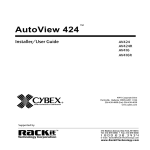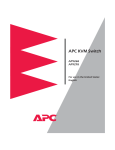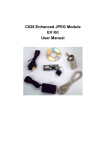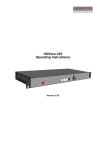Download CYBEX AUTOVIEW COMMANDER - User guide
Transcript
AutoView® 416/424 Installer/User Guide INSTRUCTIONS This symbol is intended to alert the user to the presence of important operating and maintenance (servicing) instructions in the literature accompanying the appliance. DANGEROUS VOLTAGE This symbol is intended to alert the user to the presence of uninsulated dangerous voltage within the product’s enclosure that may be of sufficient magnitude to constitute a risk of electric shock to persons. POWER ON This symbol indicates the principal on/off switch is in the on position. POWER OFF This symbol indicates the principal on/off switch is in the off position. PROTECTIVE GROUNDING TERMINAL This symbol indicates a terminal which must be connected to earth ground prior to making any other connections to the equipment. ® AutoView 424 Installer/User Guide Avocent, the Avocent logo and The Power of Being There are trademarks of Avocent Corporation. AutoView and LongView are registered trademarks of Cybex Computer Products Corporation. All other marks are the property of their respective owners. © 2002 Avocent Corporation. All rights reserved. USA Notification Warning: Changes or modifications to this unit not expressly approved by the party responsible for compliance could void the user's authority to operate the equipment. Note: This equipment has been tested and found to comply with the limits for a Class A digital device, pursuant to Part 15 of the FCC Rules. These limits are designed to provide reasonable protection against harmful interference when the equipment is operated in a commercial environment. This equipment generates, uses and can radiate radio frequency energy and, if not installed and used in accordance with the instruction manual, may cause harmful interference to radio communications. Operation of this equipment in a residential area is likely to cause harmful interference in which case the user will be required to correct the interference at his own expense. Canadian Notification This digital apparatus does not exceed the Class A limits for radio noise emissions from digital apparatus set out in the Radio Interference Regulations of the Canadian Department of Communications. Le présent appareil numérique n’émet pas de bruits radioélectriques dépassant les limites applicables aux appareils numériques de la classe A prescrites dans le Règlement sur le brouillage radioélectrique édicté par le Ministère des Communications du Canada. Japanese Notification Agency Approvals UL 1950, CSA C22. 2 No. 950, EN60950, IEC 60950 FCC part 15A, EN55022, EN55024 Table of Contents Chapter 1: Product Overview Features and Benefits . . . . . . . . . . . . . . . . . . . . . . . 3 Compatibility . . . . . . . . . . . . . . . . . . . . . . . . . . . . . 6 Safety Precautions . . . . . . . . . . . . . . . . . . . . . . . . . . 6 Chapter 2: Installation Getting Started . . . . . . . . . . . . . . . . . . . . . . . . . . . . 9 Rack Mounting your AutoView Unit . . . . . . . . . . 9 Installing an AutoView Switch . . . . . . . . . . . . . . 11 Attaching Multiple AutoView 424 Units . . . . . . . 15 Chapter 3: Basic Operations Operating the AutoView 424 . . . . . . . . . . . . . . . . 19 Activating OSD . . . . . . . . . . . . . . . . . . . . . . . . . . . 19 Setting Up the On-Screen Display (OSD) . . . . . . 21 Setting User Station Security . . . . . . . . . . . . . . . . 26 Scanning your AutoView System . . . . . . . . . . . . 28 Resetting your Mouse . . . . . . . . . . . . . . . . . . . . . . 30 Displaying Version Information . . . . . . . . . . . . . 31 Keyboard Switching . . . . . . . . . . . . . . . . . . . . . . . 31 Chapter 4: Advanced Operations Multiuser Operation . . . . . . . . . . . . . . . . . . . . . . . 37 Keyboard Translation . . . . . . . . . . . . . . . . . . . . . 38 Appendices Appendix A: FLASH Upgrades . . . . . . . . . . . . . . .43 Appendix B: Technical Specifications . . . . . . . . . .44 Appendix C: Technical Support . . . . . . . . . . . . . .45 Appendix D: Troubleshooting . . . . . . . . . . . . . . . .46 1 Product Overview Contents Features and Benefits . . . . . . . . . . . . . . . . . . . . . . . . . 3 Compatibility . . . . . . . . . . . . . . . . . . . . . . . . . . . . . . . 6 Safety Precautions . . . . . . . . . . . . . . . . . . . . . . . . . . . 6 Chapter 1: Product Overview 3 Chapter 1: Product Overview Features and Benefits The AutoView 424 KVM switch allows you to control up to 256 PC, Sun or USB computers with one keyboard, monitor and mouse. It supports Sun workstations, USB computers, IBM PC/AT and PS/2 systems and 100% compatible machines with support for VGA, SVGA, XGA and XGA-II video. Sun and PS/2 keyboard and mouse peripherals connect through the rear of the unit. Multiplatform The AutoView 424 adds multiplatform capabilities to your switching system by simultaneously supporting any combination of PS/2, Sun or USB computers in the same system. Switch easily across platforms with the AutoView 424 on-screen menu system. Multiuser/extended access capability The AutoView 424 supports two simultaneous users in the system. This second user may be placed up to 500 feet away from the AutoView 424 system. Built-in extension lets you place your second keyboard, monitor and mouse wherever you need them most. Within the base unit, AutoView 424 performs as a complete 2 x 24 matrix switch with both users independently accessing any of the 24 attached computers at the same time. On-Screen Display capability Configure and control your AutoView 424 switch with the On-Screen Display (OSD). Name your computer channels anything you wish, then select the desired computer from an easy-to-use menu. Secondary menus let you configure and initiate channel scanning and other system features. Advanced security for total control over system access Use the advanced multilevel security feature to configure and control server access for every type of user in the system. The administrator has full access privileges, while individual users can have viewing or viewing/editing capability for each attached server. FLASH upgrade capability The AutoView 424 switch is FLASH upgradable. This allows you to update your firmware at any time through a simple serial connection to insure that your AutoView 424 is always running the most current version available. 4 AutoView 424 Installer/User Guide Mouse support The AutoView 424 offers support for numerous PS/2 mice including: IBM ScrollPoint, Logitech MouseMan Wheel, Logitech Trackman Marble Wheel, Logitech Trackman Marble FX, Kensington 4 Button Mouse, Microsoft Explorer Mouse and the Microsoft IntelliMouse family. Plug and Play The AutoView 424 supports Plug and Play video and is compliant with the VESA DDC2B standard. Mouse translation For added compatibility with your current equipment, AutoView 424 features mouse translation capability. Operated through the AutoView 424, your mouse will work with any attached computer - regardless of whether the computer is Sun, USB or PS/2 mouse compatible. Expansion for up to 64 computers An AutoView 424 unit will support from one to 24 attached computers, or channels, depending on the model. If more than 24 channels are needed, multiple units can be cascaded together for expansion. An extra tier of units can be connected for a total of 256 attached computers in one system. Keep Alive feature The AutoView 424 Keep Alive feature allows attached servers to power the unit in the event of an AutoView 424 power failure. This prevents attached computers from locking up and keeps you from losing valuable time and data. OSD Configuration Utility The OSD Configuration Utility allows the administrator to easily configure and download a channel list with defined users and access privileges to the entire system. This utility will also read and save your current configuration for extra security. AutoBoot technology The AutoBoot feature boots all attached servers during initial power up or after a power failure. Computers are booted transparently without operator intervention, and may be powered up one at a time or all at once. When the power stabilizes, a channel may be selected. Chapter 1: Product Overview 5 Built-in scanning capability A built-in scanning feature allows you to automatically monitor, or scan, connected computers without intervention. When keyboard activity is detected, scanning is suspended until all activity stops. Scanning then resumes with the next channel in sequence. Keyboard switching In addition to using the on-screen menus, you can also switch computer channels with a simple keyboard sequence. 16-port version The AutoView 424 is also available in a 16-port version known as the AutoView 416. Aside from the number of ports, all information in this manual that applies to the AutoView 424 is also applicable to the AutoView 416. A typical AutoView 424 configuration is shown below. Extended Access User LongView AutoView 424 CAT5 Connection KVM-Connection to Servers KVM-Connection to Switch Figure 1.1: AutoView 424 Configuration Analog User 6 AutoView 424 Installer/User Guide Compatibility XGA/XGA-II support If you wish to use XGA or XGA-II video, you will need to purchase an adaptor available through Avocent. Safety Precautions To avoid potential video and/or keyboard problems when using Avocent products: • If the building has 3-phase AC power, ensure that the computer and monitor are on the same phase. For best results, they should be on the same circuit. • Use only Avocent-supplied cable to connect computers and KVM switches. Avocent warranties do not apply to damage resulting from user-supplied cable. To avoid potentially fatal shock hazard and possible damage to equipment, please observe the following precautions: • Do not use a 2-wire extension cord in any Avocent product configuration. • Test AC outlets at the computer and monitor for proper polarity and grounding. • Use only with grounded outlets at both the computer and monitor. When using a backup power supply (UPS), power the computer, the monitor and the AutoView 424 unit off the supply. NOTE: The AC inlet is the main disconnect. Rack mount safety considerations • Elevated Ambient Temperature: If installed in a closed rack assembly, the operation temperature of the rack environment may be greater than room ambient. Use care not to exceed the rated maximum ambient temperature of the unit. • Reduced Air Flow: Installation of the equipment in a rack should be such that the amount of airflow required for safe operation of the equipment is not compromised. • Mechanical Loading: Mounting of the equipment in the rack should be such that a hazardous condition is not achieved due to uneven mechanical loading. • Circuit Overloading: Consideration should be given to the connection of the equipment to the supply circuit and the effect that overloading of circuits might have on overcurrent protection and supply wiring. Consider equipment nameplate ratings for maximum current. • Reliable Earthing: Reliable earthing of rack mounted equipment should be maintained. Pay particular attention to supply connections other than direct connections to the branch circuit (for example, use of power strips). 2 Installation Contents Getting Started . . . . . . . . . . . . . . . . . . . . . . . . . . . . . . 9 Rack Mounting your AutoView Unit . . . . . . . . . . . . 9 Installing an AutoView Switch . . . . . . . . . . . . . . . . 11 Attaching Multiple AutoView 424 Units . . . . . . . . 15 Chapter 2: Installation 9 Chapter 2: Installation Getting Started Before installing your AutoView 424 system, refer to the lists below to ensure that you have all the items that shipped with the AutoView 424 as well as all other items necessary for proper installation. Supplied with the AutoView 424 Your AutoView 424 switch package contains the following items: • AutoView 424 unit • Local country power cord • AutoView 424 Installer/User Guide • AutoView 424 Quick Installation Guide • Download Instructions Optional items • 19 inch Switch Mounting Bracket kit (available from Avocent) • Serial cable, DB9 female • Adaptors (available from Avocent) Rack Mounting your AutoView Unit You can either place your AutoView appliance on your desktop or rack mount your unit into an EIA standard rack. Obtain a Rack Mounting Bracket Kit (1U) from Avocent to rack mount your AutoView. Before installing the switch and other components in the rack, stabilize the rack in a permanent location. Start rack mounting your equipment at the bottom of the rack, then work to the top. CAUTION: Rack Loading - Overloading or uneven loading of racks may result in shelf or rack failure, causing damage to equipment and possible personal injury. Stabilize racks in a permanent location before loading begins. Mount components beginning at the bottom of the rack, then work to the top. Do not exceed your rack load rating. CAUTION: Power Considerations - Connect only to the power source specified on the unit. When multiple electrical components are installed in a rack, assure the total component power ratings do not exceed circuit capabilities. Overloaded power sources and extension cords present fire and shock hazards. 10 AutoView 424 Installer/User Guide To install the rack mounting bracket: 1.Remove the side screws that secure the cover on your AutoView unit. 2. Line up the holes in the side brackets with the screw holes in the sides of the AutoView unit. 3. Using the previously removed screws, thread one through each of the holes in the sides of the rack mount brackets and into the AutoView cover. Tighten them securely. 4. Install a snap on nut (provided) onto one end of the cable support rod. Insert the rod through both brackets as shown above. Install the remaining acorn nut on the other end of the support rod. 5. Tie wraps can be used to secure cables to the support rod. Figure 2.1: Rack Mounting Diagram Chapter 2: Installation 11 Installing an AutoView Switch Installing your AutoView 424 The diagram below illustrates one possible configuration for your AutoView 424 switch. Follow the step-by-step procedure To install an AutoView 424 switch to properly install your new switch. Extended Access User (Via LongView) TM POWER KVM EXTENDER Local User AutoView 424 DB9 Serial Port for Updating Firmware Server 1 Servers 2-18 Figure 2.2: AutoView 424 Installation Example WARNING: To reduce the risk of electric shock or damage to your equipment - Do not disable the power cord grounding plug. The grounding plug is an important safety feature. - Plug the power cord into a grounded (earthed) outlet that is easily accessible at all times. - Disconnect the power from the unit by unplugging the power cord from either the electrical outlet or the unit. 12 AutoView 424 Installer/User Guide To install an AutoView 424 switch: 1. Power down all computers that will be part of your AutoView 424 system. 2. Plug your VGA monitor cable into the port labeled on the back of your AutoView 424. For Sun support, plug your Sun connector into the port labeled SUN and for PS/2 peripherals, plug your PS/2 keyboard cable and your PS/2 mouse cable into the ports labeled and respectively. NOTE: A PS/2 keyboard will not function if a Sun keyboard is attached. However, you may use a PS/2 mouse with a Sun keyboard. 3. Locate the input cable appropriate to the computer you are connecting. AutoView 424 cable types are identified below. Plug this cable into any numbered channel port on the rear of the AutoView 424. The other end of the input cable will have up to three connectors depending on type. Plug these connectors into the matching ports on your computer. AutoView 424 Cable Types Cable Description Length CIFCM-4 CIFCM-8 CIFCM-15 CIFCM-30 PS/2 only/VGA PS/2 only/VGA PS/2 only/VGA PS/2 only/VGA 4 ft 8 ft 15 ft 30 ft CUSBM-4 CUSBM-8 CUSBM-12 USB/VGA USB/VGA USB/VGA 4 ft 8 ft 12 ft CWSNM-4 CWSNM-8 CWSNM-15 CWSNM-30 SUN Kbd/Mouse 13W3 SUN Kbd/Mouse 13W3 SUN Kbd/Mouse 13W3 SUN Kbd/Mouse 13W3 4 ft 8 ft 15 ft 30 ft CVSNM-4 CVSNM-8 CVSNM-15 CVSNM-30 SUN Kbd/Mouse VGA SUN Kbd/Mouse VGA SUN Kbd/Mouse VGA SUN Kbd/Mouse VGA 4 ft 8 ft 15 ft 30 ft 4. Locate your next input cable. Repeat step 3 until all computers are properly attached to the AutoView 424. 5. Locate the power cord that came with your AutoView 424 unit and plug it into the IEC power connector on the AutoView 424. Make sure that the power switch is off, then plug the other end of the power cord into an appropriate AC wall outlet. This outlet must be near the equipment and easily accessible to allow for unplugging prior to any servicing of the unit. 6. Power up your AutoView 424 unit first, then power up all attached computers. Chapter 2: Installation 13 NOTE: The AutoView 424 and all attached computers should be powered down before servicing the unit. Always disconnect the power cord from the wall outlet. To connect an extended access PS/2 user station: 1. Plug a standard Category 5 Unshielded Twisted Pair cable (up to 500 feet) into the RJ-45 style modular jack on the rear of the AutoView 424. Avocent C5T or Avocent P5T cable is strongly recommended to achieve best performance and maximum distance. If you use a different Category 5 cable, make sure it is terminated to the EIA (TIA) 568 B standard, commonly used for 10BaseT Ethernet. 2. Route the Category 5 cable to the location where you intend to place the secondary monitor, keyboard and mouse. 3. Connect your monitor, keyboard and mouse to the connectors on the rear of the LongView receiver just as you would connect them to your computer. Make sure you connect your monitor’s power supply to appropriate electrical outlets. NOTE: The connector on the rear of the receiver is not used in any AutoView 424 configuration. Do not connect anything to this connector. 4. Connect the Category 5 cable to the modular jack on the rear of the receiver. 5. Connect the circular power plug from the wall mount power supply to the power port on the LongView receiver. Then plug the power supply into a convenient electrical outlet. Verify that the receiver’s power LED is now lit. To connect an extended access Sun user station: NOTE: This will require a VAK-1 adaptor kit available from Avocent. 1. Plug a standard Category 5 Unshielded Twisted Pair cable (up to 500 feet) into the RJ-45 style modular jack on the rear of the AutoView 424. Avocent C5T or Avocent P5T cable is strongly recommended to achieve best performance and maximum distance. If you use a different Category 5 cable, make sure it is terminated to the EIA (TIA) 568 B standard, commonly used for 10BaseT Ethernet. 2. Route the Category 5 cable to the location where you intend to place the secondary monitor, keyboard and mouse. 3. If your monitor uses a 13W3 plug, connect the 15HDD male adaptor to the port of your LongView receiver and your monitor cable to your VAK-1 video adaptor. Otherwise, plug your monitor directly into the LongView receiver. 14 AutoView 424 Installer/User Guide LongView Receiver RECEIVER VAK-1 Video Adaptor VAK-1 Keyboard/ Mouse Adaptor 13W3 Video Connector Keyboard/Mouse Connector Sun User Station Figure 2.3: Connecting Extended Access Sun Peripherals 4. Plug the ends of the 6-pin miniDIN VAK-1 keyboard/mouse adaptor into the and ports on your LongView receiver and then plug the Sun keyboard/mouse cable into the VAK-1 adaptor. 5. Connect the Category 5 cable to the modular jack on the rear of the receiver. 6. Connect the circular power plug from the wall mount power supply to the power port on the LongView receiver. Then plug the power supply into a convenient electrical outlet. Verify that the receiver’s power LED is now lit. 7. If your extended access location utilizes Sun peripherals, you will need to configure the AutoView 424 to recognize them before they can be used. To do this: a. At the local user, activate the OSD by pressing either of the keyboard Control keys twice within one second. b. Press the Control key twice more to access Administrator Commands. c. Use your Arrow keys to highlight Administrator Functions and press Enter. Chapter 2: Installation d. 15 Highlight and select the Remote User menu selection. Use the Spacebar to cycle through peripheral types and select the ones appropriate to your system. Press Enter to select. Attaching Multiple AutoView 424 Units NOTE: CIFCM cables are required for cascading. To cascade multiple AutoView 424 units: 1. Follow steps 1-5 in the procedure To install an AutoView 424 switch for each cascaded unit. 2. Plug the 25-pin “mini-D” connector of your CIFCM input cable into any available channel port on the rear of your primary AutoView 424 unit. 3. Plug the 15-pin video connector on the other end of the cable into the port labeled on your first cascading AutoView 424 unit. Plug the PS/2 mouse connector into the port. Plug the remaining 6-pin miniDIN keyboard connector into the port. AutoView 424 Primary Switch Servers 2-18 Secondary Switch Servers 2-18 Server 1 Figure 2.4: Attaching Multiple Units 16 AutoView 424 Installer/User Guide 4. Repeat steps 2-3 for every cascaded AutoView 424 unit in your system. 5. Power up your AutoView 424 unit(s) first, then all attached computers. 3 Basic Operations Contents Operating the AutoView 424 . . . . . . . . . . . . . . . . . . 19 Activating OSD . . . . . . . . . . . . . . . . . . . . . . . . . . . . 19 Setting Up the On-Screen Display (OSD) . . . . . . . . 21 Setting User Station Security . . . . . . . . . . . . . . . . . 26 Scanning your AutoView System . . . . . . . . . . . . . . 28 Resetting your Mouse . . . . . . . . . . . . . . . . . . . . . . . 30 Displaying Version Information . . . . . . . . . . . . . . . 31 Keyboard Switching . . . . . . . . . . . . . . . . . . . . . . . . 31 Chapter 3: Basic Operations 19 Chapter 3: Basic Operations Operating the AutoView 424 Your AutoView 424 may be operated in a non-secure (no password required) or secure (password required) mode. All units ship defaulted to the non-secure mode. For information on implementing password security, see Setting User Station Security in this chapter. Computers may be powered up one at a time or all at once. No operator intervention is required during booting. A computer may now be selected via the On-Screen Display menu or, if you are in non-secure mode, keyboard hotkey sequence. There is one power status LED. This green LED will be illuminated when power has been applied to the unit. Figure 3.1: AutoView 424 Front Panel Activating OSD To access the OSD Administrator Channel List: 1. Press the keyboard Control key twice within one second. 2. In non-secure mode, the Administrator Channel List appears. -orIn secure mode, the User Login window appears. Type in your user name and press Enter. The Administrator Channel List appears. -orIn secure mode, if you are the system administrator, log in as Admin, Root or Administrator. Type your password and press Enter. The Administrator Channel List appears. 3. If there is no keyboard activity, the login window will time-out after five minutes and go blank, enabling the monitor’s energy saver. Enter your OSD activation sequence to restore the login prompt. 20 AutoView 424 Installer/User Guide Figure 3.2: Administrator Channel List NOTE: All AutoView 424 units ship in the default non-secure state. For more information on secure versus non-secure operation, see the Setting User Station Security section. Viewing the status of your switch system The Administrator Channel List displays all named channels in your AutoView 424 system. They are listed alphabetically with their channel addresses and access status beside them. When in secure mode, only the channels that are accessible to the logged in user will be listed. For more information on security, see Setting User Station Security in this chapter. OSD Status Symbols Symbol Description Server connected and powered up. Server is powered down or is not operating properly. Selecting channels To select a channel in the OSD: 1. Use the Up or Down Arrow keys or the mouse to select a channel. -orPress the Home or End key to move directly to the top or bottom of the list. -orType a letter to move the highlight bar to the first channel name beginning with that letter. Press the letter repeatedly to scroll through all channels that begin with that letter from top to bottom. 2. Press Enter. Chapter 3: Basic Operations 21 To select servers without displaying the OSD: 1. Press and hold down the Num Lock key. Press and release the Minus (-) key on the numeric keypad. Now release the Num Lock key. The Command Line screen appears. 2. Type the channel address of the computer you wish to access. 3. Press Enter. For more information, see Keyboard Switching in this chapter. Setting up the On-Screen Display (OSD) All commands other than selecting servers are performed from the Administrator Commands menu. If you are operating in non-secure mode or are the system administrator, you will have several options that do not appear in the user level Command menu. Add Channel, Edit Channel, Delete Channel, Administrator Functions and Scanning are all covered in separate sections in this chapter. Figure 3.3: The Administrator Commands Menu 22 AutoView 424 Installer/User Guide Administrator Commands Features List Command Description Add Channel Set up the channel name, address, ID and scan dwell times. Edit Channel Edit the channel name, address, ID and scan dwell times. Delete Channel Delete a channel from the Administrator Channel List. Administrator Functions Set up administrator, users, channel switching, port setup and FLASH upgrade. Scanning Initiate the mode where the switch scans from port to port. Reset PS/2 Standard Mse/Kbd Reset the mouse and keyboard to restore correct settings. Reset PS/2 Wheel Mse/Kbd Reset the mouse and keyboard to restore correct settings. Version Information Access the version information about your system. To access the Administrator Commands menu: 1. Press the keyboard Control key twice within one second. 2. In non-secure mode, the Administrator Channel List appears. -orIn secure mode, the User Login window appears. Type in your user name and press Enter. The Administrator Channel List appears. -orIn secure mode, if you are the system administrator, log in as Admin, Root or Administrator. Type your password and press Enter. The Administrator Channel List appears. 3. Press the keyboard Control key twice within one second again. The Administrator Commands menu appears. 4. Press the Up or Down Arrow keys to select a specific menu or command. 5. Press Enter to access a screen or activate a command. -orPress Escape to exit the window without saving changes. Chapter 3: Basic Operations 23 Adding and maintaining channels Basic channel maintenance is performed from the Administrator Commands menu and is available if you are operating in non-secure mode or if you are the system administrator. Here you can add, delete or edit individual channels. To add a new channel: 1. Press the keyboard Control key twice within one second. The Administrator Channel List appears. 2. Press the keyboard Control key twice within one second again. The Administrator Commands menu appears. 3. Highlight Add Channel and press Enter. -orPress the Insert key. The Add Channel menu appears. Figure 3.4: The Add Channel Menu 4. Type in a new channel name, up to 14 characters long, and press Enter. 5. Type in the address for the computer you are naming and press Enter. NOTE: The address cannot be longer than two digits. For cascaded addresses, see Keyboard Switching in this chapter. 6. Enter the dwell time for the ID window and press Enter. 7. Enter the dwell time for scanning and press Enter. 8. Highlight ID Setup and press Enter. Use the Arrow keys to position the ID window where you would like it to appear when this channel is selected. Then press Enter. For further information, see Configuring the ID window later in this chapter. 24 AutoView 424 Installer/User Guide 9. Highlight Save Changes and press Enter. -orPress Escape to exit this operation without adding the channel. To edit an existing channel: 1. Highlight the channel you wish to change in the Administrator Channel List. 2. Press the Control key twice to access the Command menu. -orPress the F2 key once. (If you press F2, skip to step 4.) 3. Select Edit Channel from the Command menu. 4. Enter the new channel name, address, ID dwell time and Scan dwell time. Press Enter to accept. 5. Highlight ID Setup and press Enter. Use the Arrow keys to position the ID window where you would like it to appear when this channel is selected. Press Enter. For more information, see Configuring the ID window later in this chapter. 6. Select Save Changes and press Enter. To delete an existing channel: 1. Highlight the channel you wish to delete in the Administrator Channel List. 2. Press the Control key twice to access the Command menu. -orPress the Delete key. (If you press Delete, skip to step 4.) 3. Highlight Delete Channel. 4. Type Y or N at the prompt to confirm the deletion and press Enter. Configuring the ID window The ID window appears when you change channels and displays the name of the selected channel. This window can be individually configured for each channel in your system. The characteristics of the ID window can be changed from the Edit Channel menu. This option is only available if you are operating in non-secure mode or if you are the system administrator. Chapter 3: Basic Operations 25 To change the size, color and position of the ID window: 1. Highlight the channel you wish to change in the Administrator Channel List. 2. Press the Control key twice. -orPress F3. (If you press F3, skip to step 4.) 3. Highlight Edit Channel and press Enter. 4. Highlight ID Setup and press Enter. The ID window will appear. Follow the procedures outlined in the table below to change the size, color or position of your ID window. ID Window Settings Operation Procedure Move the ID window Use the Arrow keys to move the ID window's position on the monitor. (Hold down the Shift key to move slower.) If the window flickers but does not move, continue tapping the Arrow keys until it moves back into range. Change window background color Press the Page Up key to cycle through the available window background colors. Change text color Press the Page Down key to cycle through the available text colors. Change window length Use the Plus (+) and Minus (-) keys to change the length of the ID window. Change window size Press the Spacebar to toggle between large and small. ID window Help Press F1. 5. Press Enter to accept the changes or press Escape to exit the menu without saving the changes. Setting the ID window dwell time This menu selection lets you set the time that the ID window remains on screen after a channel switch. Each channel can be configured independently. The default time is set for five seconds. To set the ID window dwell time: 1. Highlight the channel you wish to change in the Administrator Channel List. 2. Press the Control key twice to access the Administrator Commands menu. 3. Highlight Edit Channel and press Enter. 26 AutoView 424 Installer/User Guide 4. Highlight ID Dwell Time. Enter a number between Ø-255 seconds. Entering Ø disables the ID window. Entering 255 allows the ID window to stay on screen the entire time the channel is active. 5. Highlight Save Changes and press Enter. Setting User Station Security The Administrator Functions menu allows you to set up the administrator and user accounts, enable and disable the setup port and utilize the AutoView 424 FLASH upgrade feature. The table below discusses the security features. Security Operating Modes Feature Description Administrator Setting up an administrator account with a password places your system in secure mode. A lock symbol will appear to the right of the screen headings to indicate secure operation. Non-secure systems do not use passwords. To return your system to the default of nonsecure mode, simply delete the administrator password. When the administrator password is enabled, user passwords must also be entered or the switch will not be completely secure. The default for users is no password. Simply press Enter at the prompt. If you configure an administrator password from this menu, your system will then be in secure mode. A lock symbol will appear to the right of the menu headings to indicate secure operation. Logout Capability You have the option of automatically logging out of the system after an administrator defined period of inactivity. Time-out values can be set from Ø to 60 minutes. (Default is five minutes.) A value of Ø keeps the user logged in continuously. When the time-out is reached, the current channel is deselected and the display goes to the login prompt. Users must log in again to access system computers. This option is only available in secure mode. Multiple User Logins You can create up to four user login accounts in addition to the system administrator. Use these accounts to configure and control server access for every type of system user. The administrator has full access privileges. Additional users can have viewing or viewing with keyboard and mouse control capability for each attached server. This option is only available in secure mode. To access the Administrator Functions menu: 1. Press the Control key twice to access the Administrator Channel List. 2. Press the Control key twice more to access Administrator Commands. 3. Highlight Administrator Functions and press Enter. Chapter 3: Basic Operations 27 To create the administrator account: 1. Press the Control key twice to access the Administrator Channel List. 2. Press the Control key twice again to access the Command menu. 3. Select Administrator Functions - Setup Administrator. The Administrator Setup screen appears. 4. Type your password and press Enter. (The password is not case sensitive.) 5. Re-enter the password for confirmation. 6. Enter the number of minutes you wish to pass without keyboard/mouse activity before the administrator is automatically logged out of the system. Entering Ø keeps the administrator logged on continuously; 60 is the maximum setting. CAUTION: Security is enabled once the password has been created. Store a copy of your password in a safe place. You should now see the option F10 - Logout at the bottom of your Administrator Channel List and a lock symbol to the right of the menu headings. To set up additional users: 1. Press the Control key twice to access the Administrator Channel List. 2. Press the Control key twice again to access the Command menu. 3. Select Administrator Functions - Setup User 1. 4. Highlight Name and type the name for this user. 5. Highlight Password and type the password, then confirm it for this user. (Passwords are not case sensitive.) 6. Highlight Logout Time. Type a value in minutes for this user’s logout time. A value of Ø keeps the user logged on continuously; 60 is the maximum setting. The default is set for 5 minutes. 7. Highlight Access Setup. You will see a listing of all attached servers in the channel list. For each server, choose a level of access for this user by selecting one of the function keys listed on the screen: F5 for no access, F6 for video only or F7 for video and keyboard/mouse capability. The default is set for full access. All changes go into effect immediately. Press Enter when you are finished. 8. Press Enter to accept your selections and repeat steps 3-7 for each remaining user. 28 AutoView 424 Installer/User Guide To assign the extended access user peripheral type: 1. Press the Control key twice to access the Command menu. 2. Highlight Administrator Functions - Remote User. 3. Press the Space key to toggle between either PS/2 or Sun peripherals and press Enter. To assign the power state selection: 1. Press the Control key twice to access the Command menu. 2. Highlight Administrator Functions - Switch To. 3. Press the Space key to toggle between either Powered Channels or All Channels to set the type of system the AutoView 400 will switch to. If Switch To is toggled to All Channels, the AutoView 400 will switch to a connected system regardless of power state. By default, the AutoView will only switch to systems that are powered up. To enable the setup port: 1. Press the Control key twice to access the Command menu. 2. Highlight Administrator Functions - Setup Port. 3. Press the Space key to toggle between either For OSD Utility or Disabled. If you enable the setup port, you can automatically program the OSD via the OSD Configuration Utility or perform FLASH upgrades. Depending on the application, you may be asked to enable the setup port in the instructions that come with your AutoView enhancement. Performing FLASH upgrades FLASH upgrading allows you to update the code that runs your AutoView 424 and keep it current with the latest firmware revisions. For more information, see Appendix A. Scanning your AutoView System The AutoView 424 scanning feature allows you to automatically monitor, or scan, your computer channels without intervention. When keyboard activity is detected, scanning is suspended until all keyboard activity stops. Scanning then resumes with the next channel in sequence. The length of time each channel remains on the screen, or dwell time, is configurable and can be changed at any time. Chapter 3: Basic Operations 29 Scanning options There are multiple ways to scan through the channels in your AutoView 424 system, either by name, address or list. NOTE: The AutoView 424 only scans the computers that are in your OSD list. • Scanning by address allows you to view each of your active channels in the order that they are attached to the AutoView. • Scanning by name allows you to scan channels in alphanumeric order according to the Administrator Channel List. • Scanning by list allows you to create a customized scanning order for the switch to follow. Any active port in the system can be scanned in any order, as many times as desired. With all scan methods, you can adjust the dwell time for each channel or omit a channel from the scan sequence completely. Choose whichever method is most appropriate for your configuration. To scan using the OSD menu: 1. Press the Control key twice to access the Administrator Channel List. 2. Press the Control key twice again to access the Command menu. 3. Highlight Scanning. Use the Spacebar to toggle through the list of options: Off, by Name, by Address or by List. 4. Press Enter. To scan using a keyboard hotkey sequence: See Keyboard Switching later in this chapter. The following key sequences control scanning. Keyboard Hotkey Sequences Key Sequence Action <CM>SG<Enter> Enables the scan Go command (by address only). <CM>SH<Enter> Enables the scan Halt command. Setting up a custom scan list Scanning by list allows you to create a customized scanning order for the switch to follow. Any active channel in the system can be scanned in any order, as many times as desired. 30 AutoView 424 Installer/User Guide To access the Administrator Scan List menu: 1. Press the Control key twice to access the Administrator Channel List. 2. Press the Control key twice again to access the Command menu. 3. Highlight Setup Scan List and press Enter. The Administrator Scan List menu appears. Figure 3.5: Configuring the Scan List To add a channel to the Scan List: 1. Press the F2 key to open a new selection. 2. Type the address of the channel you want to add to the list. The dwell time and channel name are updated automatically from the channel configuration menu. 3. Press Enter to save the new entry. To delete a channel from the Scan List: 1. Use the Arrow keys to highlight the channel you wish to delete. 2. Press the F3 key. 3. Press Enter to confirm the deletion. Resetting your Mouse If your mouse locks up during normal use with the AutoView, you may be able to re-establish operation by issuing a reset command. The reset command sends a hot-plug sequence to the server. The hot-plug sequence to a Plug and Play server causes the mouse settings to be sent to the AutoView. With communication re-established, functionality is restored to you. Chapter 3: Basic Operations 31 To reset the mouse values: 1. From the Administrator Channel List, press the Control key twice to access the Command menu. 2. Highlight either Reset PS/2 Standard Mse/Kbd or Reset PS/2 Wheel Mse/Kbd, depending on the type of mouse you are using. 3. Press Enter to activate the reset. Displaying Version Information Use the Version screen to display the system firmware. This information facilitates system troubleshooting and support. For optimum performance, keep your firmware current. To display version information: 1. From the Administrator Channel List, press the Control key twice to access the Command menu. 2. Highlight Version Information and press Enter. The Version screen appears. Keyboard Switching One of the ways to change the active channel in a non-secured AutoView 424 system is by entering a short sequence of keystrokes on the keyboard. This is called keyboard, hotkey or soft switching. In addition, there are a variety of commands that can be activated via the keyboard without having to access the OSD. The following procedures and tables describe your options. NOTE: Hotkey switching is only available in the default non-secure state. For more information on secure versus non-secure operation, see the Setting User Station Security section of this chapter. Using the Command Mode The first set of keystrokes places your system in Command Mode. A gray window with a command line will appear. As long as you are operating in Command Mode, whatever you type will be interpreted as channel switch commands until the Enter or the Escape key is pressed to terminate Command Mode. None of the keystrokes entered will be forwarded to the attached computer until you exit Command Mode. 32 AutoView 424 Installer/User Guide To activate the Command Line: 1. Press and hold down the Num Lock key. 2. Press and release the Minus (-) key on the numeric keypad. 3. Release the Num Lock key. The Command Line screen appears. NOTE: In the following tables, the Command Mode procedure is referred to by the <CM> symbol. When you see this symbol, perform the above key sequence. To select servers without displaying the OSD: 1. Press the <CM> sequence to access the Command Line. 2. Type the channel address of the computer you wish to access. For cascaded systems, enter the address of the base unit, then the address of the cascaded unit. Example: You have an AutoView unit cascaded from channel 2 of your base unit. To access the computer at channel 3 of this second (cascaded) unit, type 2.3. 3. Press Enter to accept the new channel. The table below shows an example of a hotkey switching session to demonstrate how you might switch to various channels in a system. Example Hotkey Switching Session Key Sequence Action 1.<CM>6<Enter> Selects channel 6 on the base unit as the active channel. 2.<CM>3.5<Enter> Selects the AutoView 424 attached to channel 3 on the base unit, then selects channel 5 on the cascaded unit. 3.<CM>7<Enter> Selects channel 7 on the base unit as the active channel. 4.<CM>2.1<Esc> Exit Command Mode. The instruction is not executed. Channel 7 is still the active channel. Additional Command Mode hotkey sequences In addition to switching channels, you can also use the Command Mode to control a variety of other features on your AutoView system. The following table describes these hotkey sequences. Chapter 3: Basic Operations 33 Keyboard Hotkey Sequences Key Sequence Action <CM>Kn<Enter> Sets the keyboard scan set where n is a scan set number 1-3. <CM>MR<Enter> If you hot-plug your mouse cable, you may experience a loss of mouse signal. Use this command to restore the signal if you are using a PC with a standard PS/2 mouse driver. <CM>MW<Enter> If you hot-plug your mouse cable, you may experience a loss of mouse signal. Use this command to restore the signal if you are using a PC with a Microsoft IntelliMouse or other wheel mouse driver. <CM>AV<Enter> Displays the current firmware version of your AutoView 424. <CM>SG<Enter> Enables the scan Go command (by address only). <CM>SH<Enter> Enables the scan Halt command. <CM>M+<Enter> Enables mouse suspension of scanning. <CM>M-<Enter> Disables mouse suspension of scanning. <CM>H1<Enter> Changes the hotkey sequence to the default: (NumLock, -). <CM>H2<Enter> Changes the hotkey sequence to the 1st alternate: (NumLock, *). <CM>H3<Enter> Changes the hotkey sequence to the 2nd alternate: (Ctrl, ~). <CM>OSD0<Enter> Disables the OSD sequence. <CM>OSD1<Enter> Changes the OSD sequence to the default: (Ctrl, Ctrl). <CM>OSD2<Enter> Changes the OSD sequence to the 1st alternate: (Alt, Alt). <CM>OSD3<Enter> Changes the OSD sequence to the 2nd alternate: (Shift, Shift). <CM>ZM<Enter> Use this command to resynchronize the mouse after a device or computer hot-plug. Repeat, if necessary, until synchronization is re-established. NOTE: Using the <CM>ZM<Enter> command while the mouse is operating correctly will cause the mouse to lose sync. 34 AutoView 424 Installer/User Guide 4 Advanced Operations Contents Multiuser Operation . . . . . . . . . . . . . . . . . . . . . . . . 37 Keyboard Translation . . . . . . . . . . . . . . . . . . . . . . . 38 Chapter 4: Advanced Operations 37 Chapter 4: Advanced Operations Multiuser Operation The AutoView 424 switch provides advanced features that go beyond those available in the standard AutoView Commander. Primarily, it offers the benefit of adding a LongView receiver to provide for an extended access user that may be located up to 500 feet away from the AutoView 424. As an extended access user, you have all the capabilities of the local user and can access any computer attached to the AutoView 424 system just as if sitting in front of it. Within the base unit, there are two ways to utilize the multiuser capabilities of the AutoView 424. You can access computers independently or share access with the other user. Independent vs. Shared Connections Connection Type Behavior Independent Connection Both users have keyboard and mouse control when they are accessing separate channels on the primary unit. Shared Connection One user has keyboard and mouse control for a specific channel; the remaining user can only view that channel. The second user cannot take control of the peripherals until the first user stops all keyboard and mouse activity. Single Switch Access Examples User 1 User 2 User 1 Primary Unit User 2 Primary Unit 10 4 22 24 10 4 22 24 Figure 4.1: Independent Access Figure 4.2: Shared Access User 1 is accessing server 24. User 2 wants to User 1 is accessing server 24. User 2 wants to access any of the other servers on the primary unit. access server 24. Behavior: Any keyboard stroke or mouse click by User 2 will be passed to the currently selected server. Behavior: Activities of User 1 can be monitored but only one user can enter data through the keyboard or mouse at any given time. When User 1 stops all activity, User 2 can then take control of the server. 38 AutoView 424 Installer/User Guide Multiuser operation in a multiple switch system In a multiple switch system, users will operate in independent access mode. Both users can simultaneously and independently access any computer attached to the primary AutoView unit. Similarly, independent access is possible across the cascaded units as long as each user is accessing a different secondary unit. Multiple Switch Access Example User 1 User 2 Primary Unit 3 4 Secondary Unit C Secondary Unit A C1 C2 C3 C4 A1 A2 A3 A4 Figure 4.3: Independent Operation in a Multiple Switch System User 1 is working on channel 4 of the secondary unit A. User 2 wants to access channel C4. Behavior: User 2 can be independently using any computer attached to the primary unit or to secondary unit C. User 2 cannot independently access any computer attached to secondary unit A until the first user connects to a computer attached to a different unit. Keyboard Translation The AutoView 424 allows you to use PS/2 or Sun keyboards to operate any type of attached computer. However, when crossing platforms, certain keys will need to be remapped in order to provide all of the functions available on the keyboard native to that platform. For example, if you access a Sun workstation with a PS/2 keyboard, you will notice that the PS/2 keyboard does not have the Stop and Again keys that are on a true Sun keyboard. But, by turning Scroll Lock on, the F1 and F2 keys on the PS/2 keyboard function as the Sun Stop and Again keys. With Scroll Lock off, F1 and F2 function normally. Chapter 4: Advanced Operations 39 The table below shows the translations for a PS/2 keyboard to a Sun computer. All mapped functions will only be valid when the Scroll Lock is on. PS/2 Keyboard to Sun Computer Key Sun F1 STOP F2 AGAIN F3 PROPS F4 UNDO F5 FRONT F6 COPY F7 OPEN F8 PASTE F9 FIND F10 CUT F11 POWER F12 COMMAND keypad * COMPOSE NUMLOCK HELP keypad / MUTE keypad - VOL - keypad + VOL + Sun keyboards have a Power key used to power the workstation on and off. PS/2 keyboards may have a Sleep key to place the computer in a stand-by or power saving mode. Power/Sleep for USB Computers Peripheral Keyboard PS/2 Sun Key Computer Scroll Lock Shift-F11 On Win 98/2000 F11 On Win 98/Mac Sleep On Win 98/Mac Sleep Off Win 98/2000 Power On Win 98/2000 Power Off Win 98/Mac 40 AutoView 424 Installer/User Guide To issue the Power/Sleep command: Press Scroll Lock-F11 (or Sleep key) on a PS/2 keyboard. -orFor a Sun computer, press the Power key. Appendices Contents Appendix A: FLASH Upgrades . . . . . . . . . . . . . . . . 43 Appendix B: Technical Specifications . . . . . . . . . . 44 Appendix C: Technical Support . . . . . . . . . . . . . . . 45 Appendix D: Troubleshooting . . . . . . . . . . . . . . . . 46 Appendices 43 Appendices Appendix A: FLASH Upgrades To ensure optimum operation, always use the latest firmware version available for your AutoView system. To upgrade your AutoView 424 firmware: 1. Download the latest FLASH firmware revision from the Avocent web site. 2. Connect a serial cable from the serial port of your computer to your setup port on the back of your AutoView. 3. You will need some form of terminal software on your attached computer so that it can communicate with the AutoView. There are several that are commercially available. Select one that you are comfortable with and be sure that it can communicate at 38,400 baud. 4. Configure your terminal program to the following settings: 38,400 Baud 8 Bits No Parity 1 Stop Bit No Flow Control 5. Activate the Administrator Channel List on your AutoView by pressing the Control key twice. Press Control twice more to activate the Administrator Commands menu, then highlight Administrator Functions. 6. Use the Down Arrow key to highlight FLASH Upgrade, then press Enter. 7. You will be prompted to indicate whether you wish to continue. Type Yes. Once you have done this, the AutoView will go into a standby mode and wait for data from the computer. NOTE: The keyboard, video and mouse are disabled during the FLASH upgrade. 8. Now send the FLASH file from your terminal program. To do this, you will need to use the transfer function of your communications software. Send the FLASH file using the XMODEM protocol. The transfer should be completed within four minutes. 9. The AutoView will automatically check the upgrade and make sure that it is valid. If the AutoView detects an error, it will abort the upgrade and prompt you to re-transfer the file. Otherwise, it will return the message Flash Upgrade Successful. 44 AutoView 424 Installer/User Guide Appendix B: Technical Specifications AutoView Product Specifications Mechanical Height: 1.7" (4.5 cm) Width: 17.2" (43.7 cm) Depth: 6.5" (16.51 cm) Weight: 6.0 lbs (2.72 kg) Environmental/Power Operating Temperature: 41° (5°C) to 104° (40°C) Storage Temperature: -4° (-20°C) to 122° (50°C) Operating Voltage: 100 - 240 VAC Power Frequency: 50 - 60 Hz Supported Hardware Computer: IBM PC/AT, PS/2, Sun workstations, USB computers and 100% compatibles Video Modes: VGA, SVGA, (XGA, XGA-II with adaptor) Maximum Resolution: 1600 x 1200 @ 85 Hz Peripherals: PS/2 keyboard, PS/2 mouse, Microsoft Explorer mouse, Microsoft IntelliMouse Family, IBM Scrollpoint, Logitech Mouseman Wheel, Logitech Trackman Marble wheel, Logitech Marble FX and Kensington 4 button mouse, Sun Type 5 and Type 6. Agency Approvals UL 1950, CSA C22.2 No. 950, EN60950 FCC part 15A, EN55022, EN50082 LongView Product Specifications Mechanical Height: 1.9" (4.8 cm) Width: 8.1" (20.6 cm) Depth: 4.8" (12.2 cm) Weight: 1 lb (0.45 kg) Environmental/Power Operating Temperature: 5°C to 40°C Storage Temperature: -20°C to 50°C Power Supply: 24Vdc @ 500mA from120 Vac adaptor Appendices 45 Appendix C: Technical Support Our Technical Support staff is ready to assist you with any installation or operating issues you encounter with your Avocent product. If an issue should develop, follow the steps below for the fastest possible service: 1. Check the Troubleshooting section of this manual to see if the issue can be resolved by following the procedures outlined. See Appendix D. 2. Check our web site at www.avocent.com/support to search the knowledge base or use the on-line service request. 3. Call Avocent Technical Support for assistance at (888) 793-8763. Visit the Avocent web site at http://www.avocent.com/support and click on Getting Support for current phone support hours. 46 AutoView 424 Installer/User Guide Appendix D: Troubleshooting No status light Verify that the unit is turned on. Check the power cable. If the problem persists, contact Avocent Technical Support. Unable to hotkey switch to a channel Check the power indicator on the OSD screen to ensure that the system in question is powered. Verify that you are not in secure mode (no lock symbol on OSD screen). No video Verify that the video cable between the computer and the AutoView 424 is correctly connected. Verify that the monitor cable is correctly connected to the AutoView 424. Power down the computer. Connect the monitor directly to the computer and power up again. If the monitor operates correctly direct to the computer, contact Avocent Technical Support. If it does not, try another monitor. Extended access video is unrecognizable Verify that the extended access monitor capabilities are equal to or greater than the local monitor capabilities. Plug and Play video is only supported on the local video port. Poor video quality at extended access user Verify that the length of Category 5 cable between the AutoView 424 and the LongView receiver is 500 ft or less. Make sure the video connectors at both ends are firmly seated. Make sure that the Category 5 connectors are properly inserted. Make sure that the modular plugs on the Category 5 cable were properly crimped onto the cable. Mouse jumps or “hugs” screen If the mouse has been hot-plugged while running in Windows, you may need to close and restart Windows. . If the mouse still does not function, try the mouse resynchronization command <ZM>. For instructions on Command Mode, see Basic Operations. If the problem persists, contact Avocent Technical Support. Mouse is inoperable on one computer channel If the mouse is inoperable on a channel, try the mouse reset command <MR> or <MW> with that computer selected. For instructions on the Command Mode, see Basic Operations. Verify that all of the cables going from the computer to the AutoView 424 are connected properly. Make sure that you have keyboard/mouse privileges for that channel. Verify that the mouse driver and application are configured properly for the mouse to be supported. Appendices 47 Verify that the computer works properly with a mouse connected directly to it. If the problem persists, contact Avocent Technical Support. Mouse is inoperable on all computer channels Verify that the mouse is plugged into the correct PS/2 port on the back of the AutoView 424. Try the mouse reset command <MR> or try the Reset PS/2 Standard Mse/Kbd command from the OSD Command menu for computers using PS/2 mice. Use <MW> or Reset PS/2 wheel Mse/Kbd for computers using the Microsoft IntelliMouse. For instructions on Command Mode, please see the Basic Operations chapter. Verify that the mouse works when connected directly to a computer. Cycle power to the AutoView 424 unit. You do not have to power down your computers for this. If the mouse remains inoperable, power down all attached computers, cycle power on the AutoView 424, then repower the computers. If the problem persists, contact Avocent Technical Support. Keyboard is inoperable on one computer channel If the keyboard does not function on one channel, verify that the cables from the computer to the AutoView 424 are connected properly. If you are operating in secure mode, verify your keyboard and mouse privileges. Verify that the keyboard works properly connected directly to the computer. If the problem persists, contact Avocent Technical Support. Keyboard is inoperable on all computer channels If the keyboard does not work on any channel, try the Reset PS/2 Mse/Kbd command from the OSD Command menu. Try a different keyboard. If the keyboard still does not function, cycle the power on the AutoView 424 unit. Cycle power on all attached computers and the AutoView 424 unit and try again. If the problem persists, contact Avocent Technical Support. Keyboard is inoperable after switching channels If you are operating in secure mode, verify your keyboard and mouse privileges. If the problem persists, call Avocent Technical Support. Try changing the keyboard scan set for that channel by using the keyboard command sequence <Kn>. For more information, see the Basic Operations chapter. Characters on screen do not match keyboard input Try changing the keyboard scan set for that channel by using the keyboard command sequence <Kn>. For more information, see the Basic Operations chapter. If the problem persists, call Avocent Technical Support. No keyboard, video or mouse on expansion unit; base unit is functioning properly Verify that the cable connecting the two units together is correctly connected on both ends. For additional information, see the Installation chapter. If the problem persists, contact Avocent Technical Support. 48 AutoView 424 Installer/User Guide General keyboard/video problems If the building has 3-phase AC power, ensure that the computer, the AutoView 424 and the monitor are on the same phase. Best results are obtained when they are on the same circuit. Use only Avocent supplied cable. Avocent warranties do not apply to damage resulting from user supplied cable. Do not use a 2-wire extension cord in any Avocent product configuration. Test AC outlets at computer, AutoView 424 and monitor for proper polarity and grounding. Use only with grounded outlets at the computer, AutoView 424 and monitor. When using a backup power supply (UPS), power the computer, AutoView 424 and the monitor off the supply. OSD menu does not “pop-up” Type <CM>OSD1<Enter> to activate OSD. Verify that you are pressing the Control key twice within one second. If the problem persists, contact Avocent Technical Support. Unable to change channels on OSD Verify that the channel is powered. Check the address configured in OSD. If the computer is powered and the address is correct, call Avocent Technical Support. Administrator password Call Technical Support. User password is forgotten Contact your system administrator. LIMITED WARRANTY Avocent Corporation warrants to the original retail purchaser that this product is and will be free from defects in materials and workmanship for a period of 24 months from the date of purchase. Additionally, all Avocent products carry an unconditional thirty-day satisfaction guarantee. If, for any reason, you are dissatisfied with the performance of this product, you may return it to the point of purchase for a refund of the purchase price (excluding shipping charges). This guarantee does not apply to special order products, and may not be available through all resellers. During the warranty period, purchaser must promptly call Avocent for a RETURN MATERIALS AUTHORIZATION (RMA) number. Make sure that the RMA number appears on the packing slip, proof of purchase, AND ON THE OUTSIDE OF EACH SHIPPING CARTON. Unauthorized returns or collect shipments will be refused. Ship prepaid to: Avocent Corporation 4991 Corporate Drive Huntsville, AL 35805 U.S.A. Telephone: (256) 430-4000 The above limited warranty is voided by occurrence of any of the following events, upon which the product is provided as is, with all faults, and with all disclaimers of warranty identified below: 1. 2. 3. 4. 5. 6. 7. 8. If non-Avocent approved cabling is attached to the unit. Poorly constructed and miswired cabling can diminish video quality and damage equipment. Avocent manufactured cabling is built to high quality standards utilizing overall braided shield to comply with FCC emission standards, and each cable is individually tested under load. If defect or malfunction was caused by abuse, mishandling, unauthorized repair, or use other than intended. If unauthorized modifications were made to product. If unreported damages occurred in any shipment of the product. If damages were due to or caused by equipment or software not provided by Avocent. If the unit is used with non-grounded or incorrectly polarized AC power. If the product is used in contradiction to any instruction provided by any User Guide or Instruction Sheet provided to you or with the product. If the product is damaged due to power surges, water exposure or act of God including lightning. EXCEPT AS SPECIFICALLY PROVIDED ABOVE AND TO THE MAXIMUM EXTENT ALLOWED BY LAW, AVOCENT CORPORATION DISCLAIMS ALL WARRANTIES AND CONDITIONS WHETHER EXPRESS, IMPLIED, OR STATUTORY AS TO ANY MATTER WHATSOEVER INCLUDING, WITHOUT LIMITATION, TITLE, NON-INFRINGEMENT, CONDITION, MERCHANTABILITY OR FITNESS FOR ANY PARTICULAR OR INTENDED PURPOSE. EXCEPT AS EXPRESSLY PROVIDED ABOVE AND TO THE MAXIMUM EXTENT ALLOWED BY LAW, AVOCENT CORPORATION SHALL NOT BE LIABLE FOR ANY SPECIAL, INDIRECT OR CONSEQUENTIAL DAMAGES (INCLUDING WITHOUT LIMITATION, LOSS OF PROFIT, LOSS OF BUSINESS, LOSS OF INFORMATION, FINANCIAL LOSS, PERSONAL INJURY, LOSS OF PRIVACY OR NEGLIGENCE) WHICH MAY BE CAUSED BY OR RELATED TO, DIRECTLY OR INDIRECTLY, THE USE OF A PRODUCT OR SERVICE, THE INABILITY TO USE A PRODUCT OR SERVICE, INADEQUACY OF A PRODUCT OR SERVICE FOR ANY PURPOSE OR USE THEREOF OR BY ANY DEFECT OR DEFICIENCY THEREIN EVEN IF AVOCENT CORPORATION OR AN AUTHORIZED AVOCENT DEALER HAS BEEN ADVISED OF THE POSSIBILITY OF SUCH DAMAGES OR LOSSES. ©2002 Avocent Corporation. All rights reserved. The Power of Being There ™ For Technical Support: Email: [email protected] www.avocent.com Avocent Corporation 4991 Corporate Drive Huntsville, Alabama 35805-6201 USA Tel: +1 256 430 4000 Fax: +1 256 430 4031 Avocent International Ltd. Avocent House, Shannon Free Zone Shannon, County Clare, Ireland Tel: +353 61 715 292 Fax: +353 61 471 871 Avocent Asia Pacific Singapore Branch Office 100 Tras Street, #15-01 Amara Corporate Tower Singapore 079027 Tel: +656 227 3773 Fax: +656 223 9155 Avocent Germany Gottlieb-Daimler-Straße 2-4 D-33803 Steinhagen Germany Tel: +49 5204 9134 0 Fax: +49 5204 9134 99 Avocent Canada 50 Mural Street, Unit 5 Richmond Hill, Ontario L4B 1E4 Canada Tel: +1 877 992 9239 Fax: +1 877 524 2985 590-206-102B




































































